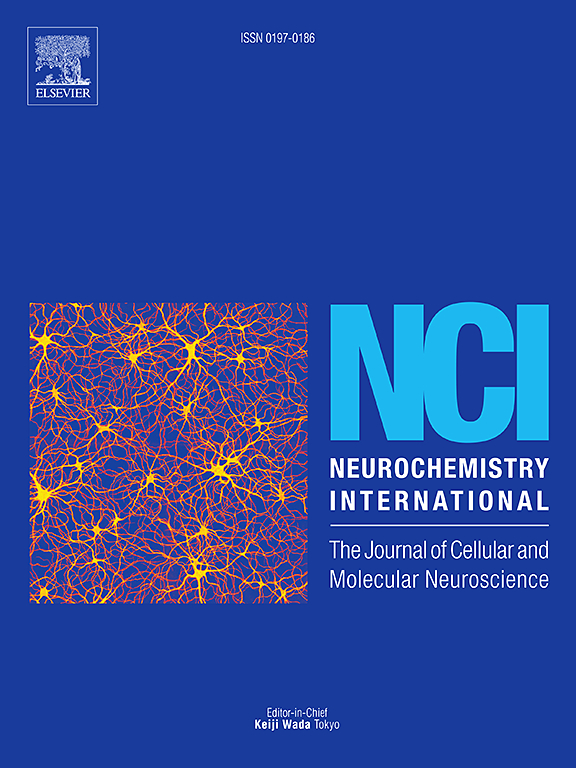VNS facilitates the neurological function recovery after ischemia/reperfusion injury by regulating the A1/A2 polarization of astrocytes through the NMU-NMUR2 pathway
IF 4
3区 医学
Q2 BIOCHEMISTRY & MOLECULAR BIOLOGY
引用次数: 0
Abstract
Stroke is the second leading cause of death worldwide. Although conventional treatments such as thrombolysis and mechanical thrombectomy are effective, their narrow therapeutic window limits long-term neurological recovery. Previous studies have shown that vagus nerve stimulation (VNS) enhances neurological recovery after ischemia/reperfusion (I/R) injury, and neuromedin U (NMU) has neuroprotective effects. This study used a mouse model of cerebral I/R injury to investigate the potential mechanisms of NMU in VNS-mediated neurological improvement. The study consisted of two parts: first, assessing the dynamic expression of NMU and NMUR2, which peaked on day 14 post-I/R. NMUR2 was primarily localized in astrocytes, suggesting that the NMU-NMUR2 signaling pathway plays an important role in astrocyte regulation. Next, interventions with VNS, NMU, and R–PSOP + VNS were conducted to evaluate the role of this pathway in VNS-mediated recovery. The results showed that VNS significantly upregulated NMU and NMUR2 expression, which was blocked by the NMUR2 antagonist R–PSOP. VNS and NMU treatment increased the proportion of A2 astrocytes, reduced A1 astrocytes, and enhanced the expression of VEGF and BDNF, all of which were also blocked by R–PSOP. These findings indicate that the "VNS-NMU-NMUR2-astrocyte A1/A2 polarization-VEGF/BDNF pathway" plays a crucial role in promoting neurovascular remodeling, axonal and dendritic regeneration, and synaptic plasticity, thereby contributing to functional recovery.
VNS 通过 NMU-NMUR2 通路调节星形胶质细胞的 A1/A2 极化,从而促进缺血再灌注损伤后神经功能的恢复。
中风是全球第二大死因。虽然传统的治疗方法如溶栓和机械取栓是有效的,但它们狭窄的治疗窗口限制了神经系统的长期恢复。已有研究表明迷走神经刺激(VNS)可促进缺血再灌注(I/R)损伤后神经系统的恢复,神经介质U (NMU)具有神经保护作用。本研究采用脑I/R损伤小鼠模型,探讨NMU在vns介导的神经系统改善中的潜在机制。本研究分为两部分:一是评估NMU和NMUR2的动态表达,NMU和NMUR2在i /R后第14天达到峰值。NMUR2主要定位于星形胶质细胞,提示NMU-NMUR2信号通路在星形胶质细胞调控中起重要作用。接下来,采用VNS、NMU和R-PSOP+VNS进行干预,以评估该途径在VNS介导的恢复中的作用。结果显示,VNS显著上调NMU和NMUR2的表达,而NMUR2的表达被NMUR2拮抗剂R-PSOP阻断。VNS和NMU处理增加了A2星形胶质细胞的比例,减少了A1星形胶质细胞,增加了VEGF和BDNF的表达,这些都被R-PSOP阻断。这些发现表明,“vns - nmu - nmur2 -星形胶质细胞A1/A2极化- vegf /BDNF通路”在促进神经血管重塑、轴突和树突再生、突触可塑性等方面起着至关重要的作用,从而有助于功能恢复。
本文章由计算机程序翻译,如有差异,请以英文原文为准。
求助全文
约1分钟内获得全文
求助全文
来源期刊

Neurochemistry international
医学-神经科学
CiteScore
8.40
自引率
2.40%
发文量
128
审稿时长
37 days
期刊介绍:
Neurochemistry International is devoted to the rapid publication of outstanding original articles and timely reviews in neurochemistry. Manuscripts on a broad range of topics will be considered, including molecular and cellular neurochemistry, neuropharmacology and genetic aspects of CNS function, neuroimmunology, metabolism as well as the neurochemistry of neurological and psychiatric disorders of the CNS.
 求助内容:
求助内容: 应助结果提醒方式:
应助结果提醒方式:


